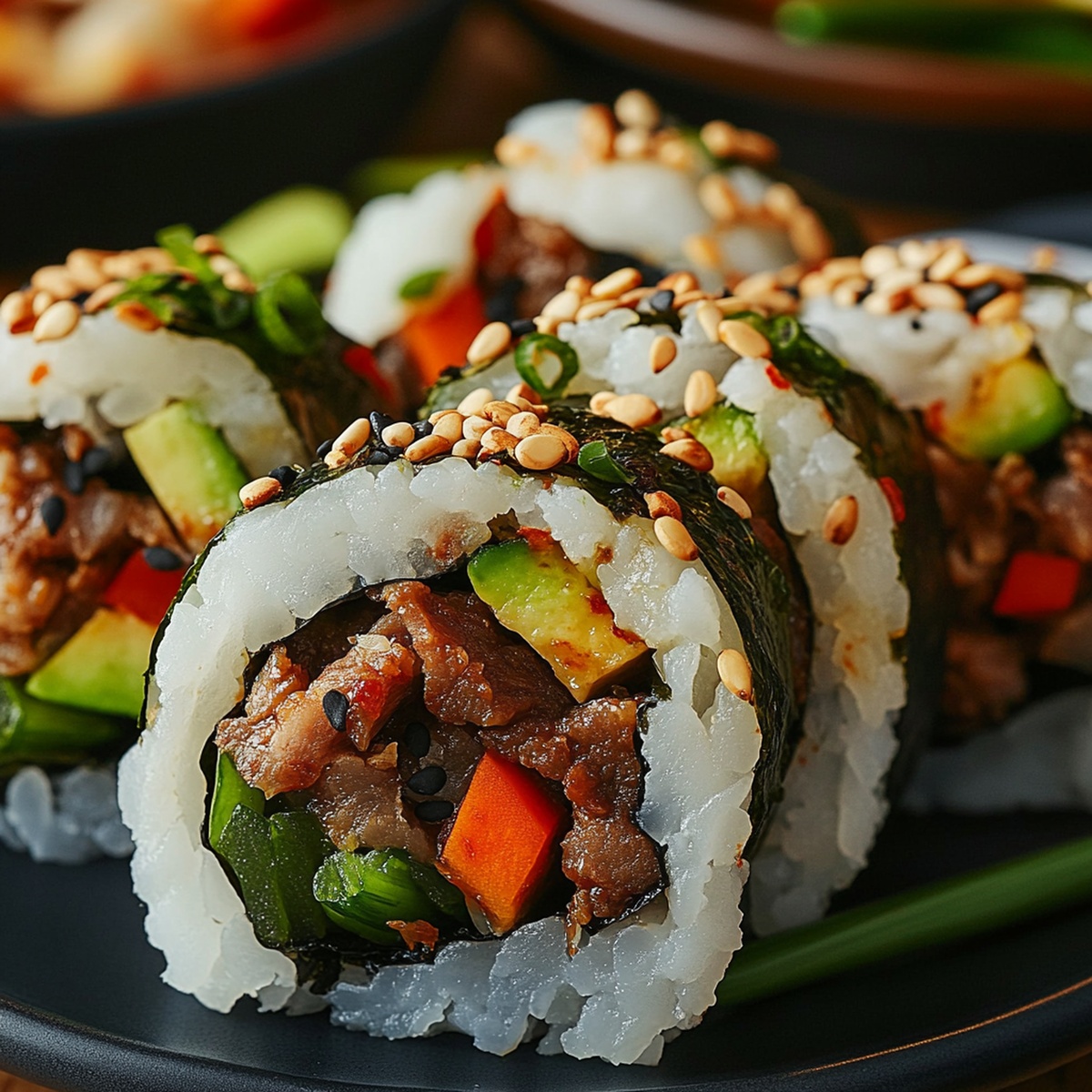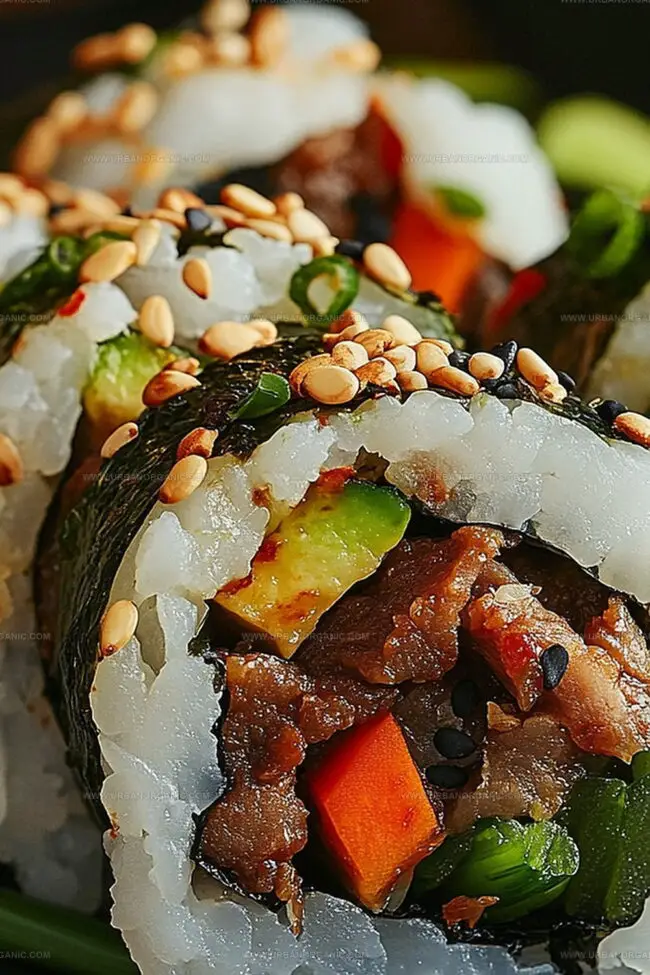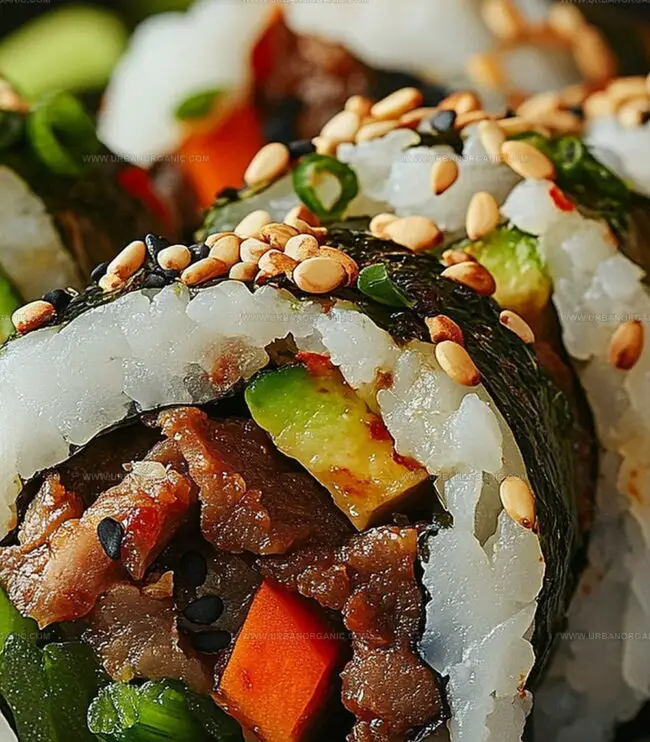Korean Bulgogi Sushi Rolls Recipe for Party-Ready Magic
My recent obsession with korean bulgogi sushi rolls has completely transformed my weekend dinner routine.
Crispy edges and tender meat create an unexpected fusion experience.
Bold flavors burst through each carefully crafted bite.
Culinary boundaries blur when traditional Korean barbecue meets Japanese rolling techniques.
Spicy marinated beef nestles against perfectly seasoned rice, promising a mouthwatering adventure.
Adventurous cooks can easily master this delightful crossover dish.
You’ll want to savor every single delectable morsel.
Bold Flavor in Bulgogi Sushi Rolls
What Goes Into Korean Bulgogi Sushi Rolls
Proteins:Seafood and Seaweed:Rice and Vinegar Components:Marinade and Seasoning Ingredients:Vegetable Fillings:Additional Seasonings:Rolling Korean Bulgogi Sushi Like a Natural
Step 1: Marinate the Bulgogi
Create a flavor-packed marinade with:Coat beef slices in the marinade and let sit for 30 minutes.
Step 2: Cook the Bulgogi
Heat a skillet over medium-high heat.
Sear beef until edges caramelize and turn golden brown.
Remove from pan and set aside to cool.
Step 3: Prepare Sushi Rice
Mix rice vinegar, sugar, and salt in a small bowl.
Fold the mixture into warm cooked rice.
Allow rice to cool to room temperature.
Step 4: Assemble Sushi Rolls
Place nori sheet on bamboo mat with shiny side facing down.
Spread rice evenly across nori, leaving a small border at the top edge.
Layer ingredients in a line near the bottom:Step 5: Roll and Shape
Use the bamboo mat to tightly roll the sushi from bottom to top.
Gently press to seal the roll.
Moisten the top edge with water to help seal.
Step 6: Slice and Garnish
Cut roll into eight equal pieces using a sharp, wet knife.
Sprinkle with extra sesame seeds.
Serve with soy sauce or gochujang mayo.
Expert Tips for Better Bulgogi Sushi Rolls
Storage and Reheating for Bulgogi Sushi Leftovers
Top Pairings for Korean Bulgogi Sushi Rolls
Creative Bulgogi Sushi Variations to Try
FAQs for Korean Bulgogi Sushi Enthusiasts
Bulgogi is thinly sliced Korean beef marinated in a sweet and savory sauce made with soy sauce, brown sugar, garlic, and sesame oil, then quickly cooked until caramelized and tender.
This recipe is a fusion dish that combines Korean bulgogi flavors with Japanese sushi roll techniques, creating a unique cross-cultural culinary experience.
Yes, you can substitute beef with chicken, pork, or even tofu for a vegetarian version while maintaining the classic bulgogi marinade and flavor profile.
You’ll need a bamboo sushi mat, sharp knife, and basic kitchen tools, but the rolling technique can be learned with a little practice and patience.
Print
Korean Bulgogi Sushi Rolls Recipe
- Total Time: 30 minutes
- Yield: 4 1x
Description
Savory Korean bulgogi sushi rolls blend traditional Japanese techniques with bold Korean flavors, creating a mouthwatering fusion that promises culinary excitement. Silky rice, tender marinated beef, and crisp vegetables roll together into a delectable bite that will transport you straight to Seoul’s vibrant street food scene.
Ingredients
Main Ingredients:
- ½ pound (226.8 grams) thinly sliced beef (ribeye or sirloin)
- 2 cups cooked sushi rice
- 5 sheets nori (seaweed)
Vegetable and Garnish Ingredients:
- 1 small cucumber, julienned
- 1 small carrot, julienned
- 1 avocado, sliced
- 34 perilla leaves (optional)
- 1 egg, cooked into a thin omelet and sliced (optional)
- 1 green onion, finely chopped
- Sesame seeds (for sprinkling)
Marinade and Seasoning Ingredients:
- 2 tablespoons soy sauce
- 1 tablespoon brown sugar
- 1 tablespoon sesame oil
- 1 teaspoon rice vinegar
- 1 ½ tablespoons rice vinegar
- 1 teaspoon sugar
- ½ teaspoon salt
- 1 teaspoon minced garlic
- ½ teaspoon grated ginger
- ½ teaspoon black pepper
- 1 teaspoon sesame seeds
- Soy sauce (for dipping)
- Gochujang mayo or spicy sriracha mayo
Instructions
- Craft a vibrant marinade by whisking together soy sauce, brown sugar, sesame oil, rice vinegar, minced garlic, grated ginger, freshly ground black pepper, toasted sesame seeds, and finely chopped green onions.
- Submerge thin beef slices in the aromatic marinade, allowing flavors to penetrate for a minimum of 30 minutes, or ideally overnight for maximum taste intensity.
- Sizzle the marinated beef in a preheated skillet over medium-high heat, creating caramelized edges and developing rich, complex flavors. Remove and let rest.
- Prepare sushi rice seasoning by blending rice vinegar, sugar, and salt until completely dissolved.
- Gently fold the seasoning into warm, freshly cooked rice, ensuring even distribution. Allow to cool to room temperature.
- Position a nori sheet on a bamboo mat with the glossy side facing downward.
- Delicately spread a uniform layer of seasoned rice across the nori, maintaining a small border at the top edge.
- Strategically layer cooked bulgogi, julienned cucumber, thinly sliced carrots, creamy avocado, and aromatic perilla leaves along the bottom third of the nori.
- Incorporate delicate omelet strips to introduce an additional textural dimension.
- Utilizing the bamboo mat, carefully roll the sushi from the bottom, applying gentle, consistent pressure to create a compact cylinder.
- Moisten the exposed nori edge with water to create a secure seal.
- Slice the roll into eight uniform pieces using a sharp knife rinsed between cuts.
- Garnish with a sprinkle of sesame seeds and serve alongside zesty soy sauce or spicy gochujang mayo for dipping.
Notes
- Marinate the beef longer for intensely rich, deeper flavor profiles that meld Korean and Japanese culinary traditions perfectly.
- Ensure rice is slightly warm when mixing vinegar mixture to help seasoning absorb evenly and create glossy, authentic sushi texture.
- Use very sharp knife and wet blade when cutting rolls to prevent rice from sticking and maintain clean, precise sushi presentation.
- Customize roll ingredients based on dietary preferences: swap beef for tofu, use cauliflower rice for low-carb version, or add extra vegetables for vegetarian adaptation.
- Prep Time: 15 minutes
- Cook Time: 15 minutes
- Category: Lunch, Dinner, Snacks
- Method: Frying
- Cuisine: Korean
Nutrition
- Serving Size: 4
- Calories: 225
- Sugar: 18 g
- Sodium: 300 mg
- Fat: 10 g
- Saturated Fat: 5 g
- Unsaturated Fat: 4.5 g
- Trans Fat: 0 g
- Carbohydrates: 30 g
- Fiber: 1 g
- Protein: 4 g
- Cholesterol: 70 mg




Jessica Martinez
Pastry Chef & Recipe Developer
Expertise
Organic Baking Techniques, Gluten-Free Recipe Development, Southwestern Dessert Specialties, Food Styling and Photography
Education
Santa Fe Community College (SFCC)
Jessica brings the sweet side to Urban Organic with her passion for baking and love for the Southwest. She trained at Santa Fe Community College and has built a career creating beautiful, gluten-free, and organic desserts that feel both nostalgic and new.
She believes baking should be fun, creative, and open to everyone, no matter your diet or skill level. Jessica’s recipes are simple enough to follow, but special enough to remember.